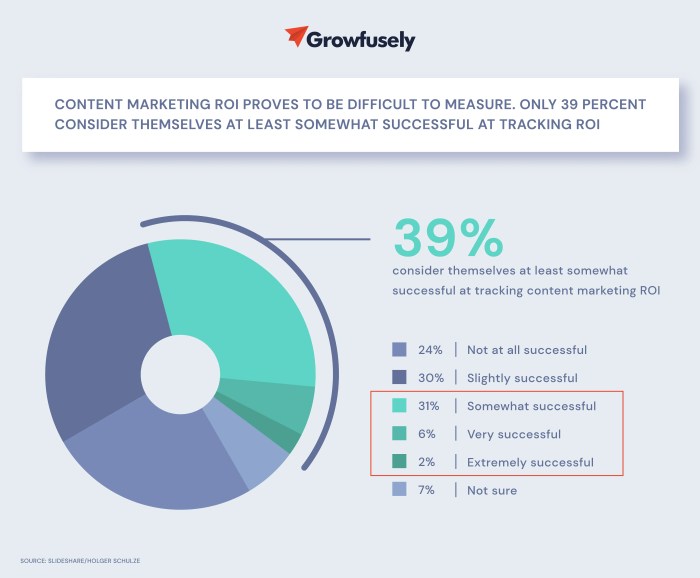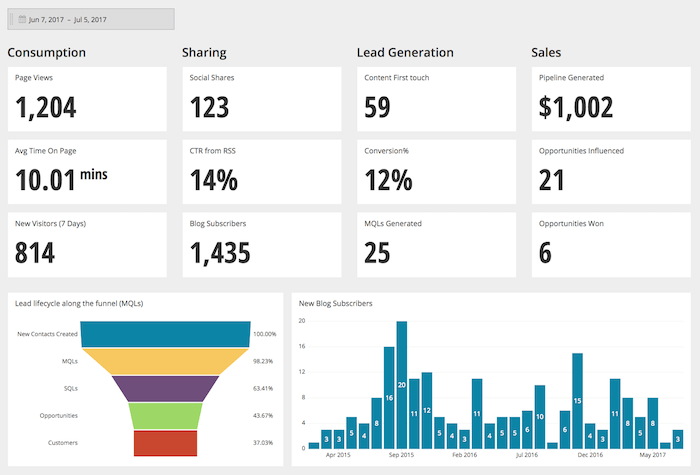Tracking Content Marketing ROI is key to maximizing success in today’s digital landscape, where every dollar counts. Dive into the world of ROI tracking and unlock the secrets to effective content marketing strategies.
Importance of Tracking Content Marketing ROI

Tracking Content Marketing ROI is like keeping score in a basketball game – you gotta know if you’re winning or losing, right? It’s crucial for content marketing strategies because it helps you see what’s working and what’s not. By tracking ROI, you can make informed decisions to optimize your marketing efforts and get the most bang for your buck.
Optimizing Marketing Budgets
When you track ROI, you can see which content pieces are driving the most engagement and conversions. This insight allows you to reallocate your budget to focus on the strategies that are delivering results. For example, if a certain blog post is bringing in a ton of leads, you can invest more resources into creating similar content to maximize your ROI.
Successful Companies Tracking ROI
Companies like HubSpot and Salesforce are known for their effective tracking of content marketing ROI. They use sophisticated analytics tools to measure the impact of their content and adjust their strategies accordingly. By consistently monitoring ROI, these companies have been able to stay ahead of the game and continuously improve their marketing efforts.
Key Metrics for Tracking Content Marketing ROI
In order to effectively measure the return on investment (ROI) of content marketing efforts, businesses rely on a variety of key metrics that provide insight into the performance and success of their campaigns.
Web Traffic, Tracking Content Marketing ROI
Web traffic is a crucial metric for tracking content marketing ROI as it indicates the number of visitors coming to your website as a result of your content. By analyzing web traffic data, businesses can determine which pieces of content are driving the most traffic and adjust their strategies accordingly.
- Tools like Google Analytics can provide detailed information on website traffic, including the sources of traffic, user behavior, and conversion rates.
- Increasing web traffic through content marketing can lead to higher brand visibility, increased leads, and ultimately, more sales.
Conversion Rates
Conversion rates are another important metric for tracking content marketing ROI, as they measure the percentage of website visitors who take a desired action, such as making a purchase or signing up for a newsletter. By monitoring conversion rates, businesses can assess the effectiveness of their content in driving conversions.
- Tools like HubSpot and Marketo offer features that allow businesses to track and analyze conversion rates, helping them optimize their content for better results.
- Improving conversion rates through content marketing can lead to a higher ROI by increasing the number of leads and customers generated from content efforts.
Customer Acquisition Cost
Customer acquisition cost (CAC) is a metric that calculates the average cost of acquiring a new customer through marketing efforts. By tracking CAC, businesses can evaluate the cost-effectiveness of their content marketing strategies and make informed decisions about resource allocation.
- Tools like Kissmetrics and Salesforce can help businesses calculate and analyze customer acquisition costs, providing valuable insights into the efficiency of their content marketing campaigns.
- Reducing customer acquisition costs through content marketing can lead to a higher ROI by maximizing the return on investment for each new customer acquired.
Challenges in Tracking Content Marketing ROI
Tracking content marketing ROI can be a complex process for businesses, presenting various challenges along the way. From attribution modeling to data accuracy, these hurdles can impact the accuracy of ROI tracking and ultimately affect decision-making. Let’s dive into some common challenges and explore strategies to overcome them.
Attribution Modeling
One of the major challenges in tracking content marketing ROI is attribution modeling. Determining which touchpoints or channels deserve credit for conversions can be tricky, especially in a multi-channel marketing environment. Without a clear understanding of how each touchpoint contributes to the overall ROI, businesses may struggle to allocate resources effectively and optimize their marketing efforts.
Data Accuracy Issues
Data accuracy is another significant challenge in tracking content marketing ROI. Inaccurate or incomplete data can skew results and lead to misleading conclusions. Issues such as tracking errors, data silos, and inconsistent reporting can hinder the ability to measure the true impact of content marketing initiatives. Without reliable data, businesses may make decisions based on flawed information, compromising their ROI tracking efforts.
Strategies to Overcome Challenges
- Implementing Multi-Touch Attribution Models: Utilize advanced attribution models that assign value to multiple touchpoints along the customer journey, providing a more comprehensive view of ROI.
- Integrating Data Sources: Ensure data accuracy by integrating various data sources and platforms to create a unified view of marketing performance.
- Regular Data Audits: Conduct regular audits to identify and correct data inaccuracies, ensuring that tracking mechanisms are functioning correctly.
- Investing in Analytics Tools: Utilize sophisticated analytics tools to track and analyze content performance, allowing for more accurate ROI calculations.
- Continuous Optimization: Continuously optimize content marketing strategies based on data insights and adjust attribution models to reflect the true impact of each touchpoint.
Best Practices for Tracking Content Marketing ROI

To set up a robust ROI tracking system for content marketing, it is crucial to follow best practices that ensure accurate measurement and analysis. By establishing clear goals and key performance indicators (KPIs), businesses can effectively track ROI and make informed marketing decisions based on data-driven insights.
Setting Clear Goals and KPIs
Before diving into tracking ROI, it is essential to define clear goals for your content marketing campaigns. These goals should align with your overall business objectives and help measure the success of your efforts. Additionally, establishing key performance indicators (KPIs) that directly relate to your goals will provide a framework for tracking and analyzing ROI effectively.
Analyzing and Interpreting ROI Data
Once you have set clear goals and KPIs, the next step is to analyze and interpret the ROI data generated by your content marketing initiatives. By examining metrics such as website traffic, lead generation, conversion rates, and customer engagement, you can gain valuable insights into the performance of your campaigns. Use this data to identify trends, measure success against set benchmarks, and make informed decisions to optimize future marketing strategies.
